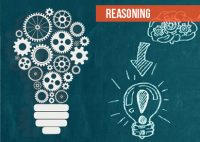Mathematical Operation For SBI PO Set – 3

Mathematical Operation For SBI PO Set – 3
1.Statements:
M ≥ U = D > T; R < S ≥ M
Conclusions:
I. M ≥ D
II. T > R
a) If either conclusions I or conclusion II is true
b)if neither conclusion I nor Conclusion II is true
c) If only conclusion I is true.
d)If both conclusion I and Conclusion II are true
e)If only Conclusion II is true
2.Statements:
P ≥ A = R ≤ E < N; R ≥ T
Conclusions:
I.A ≥ N
II. T ≤ P
a) if either conclusions I or conclusion II is true
b) if neither conclusion I nor Conclusion II is true
c) if only conclusion I is true.
d) If both conclusion I and Conclusion II are true
e) If only Conclusion II is true
3.Statements:
C ≤ H ≤ I > L; D ≥ I; L ≥ N
Conclusions:
I. D > C
II. C = D
a) If either conclusions I or conclusion II is true
b) If neither conclusion I nor Conclusion II is true
c) If only conclusion I is true.
d) If both conclusion I and Conclusion II are true
e) If only Conclusion II is true
4.Statements:
C ≤ H ≤ I > L; D ≥ I; L ≥ N
Conclusions:
I. D > L
II. N < L
a) If either conclusions I or conclusion II is true
b) If neither conclusion I nor Conclusion II is true
c) If only conclusion I is true.
d) if both conclusion I and Conclusion II are true
e) If only Conclusion II is true
5) In these questions symbols @, $, #, &, % are used with different meanings as follows.
P @ Q means P is neither smaller than nor equal to Q
P # Q means P is neither greater than nor equal to Q
P $ Q means P is neither greater nor smaller than Q
P % Q means P is not greater than Q
P & Q means P is not smaller than Q
Statements: A@B, B%C, C@D
Conclusions: I. D$B II. B@D
a) If only conclusion I is true.
b) If only conclusion II is true.
c) If either conclusion I or II is true.
d) If neither conclusion I nor II is true.
e) If both conclusions I and II is true
6) Statements: A@B, B#C, C%D
Conclusions: I. B#D II.D@A
a) If only conclusion I is true.
b) If only conclusion II is true.
c) If either conclusion I or II is true.
d) If neither conclusion I nor II is true.
e) If both conclusions I and II is true
7.In these questions symbols @, $, #, &, % are used with different meanings as follows.
P @ Q means P is neither smaller than nor equal to Q
P # Q means P is neither greater than nor equal to Q
P $ Q means P is neither greater nor smaller than Q
P % Q means P is not greater than Q
P & Q means P is not smaller than Q
Statements: P&Q, Q@R, R%S
Conclusions: I. Q%S II. P%S
a) If only conclusion I is true.
b) If only conclusion II is true.
c) If either conclusion I or II is true.
d) If neither conclusion I nor II is true.
e) If both conclusions I and II is true
8.In these questions symbols @, $, #, &, % are used with different meanings as follows.
P @ Q means P is neither smaller than nor equal to Q
P # Q means P is neither greater than nor equal to Q
P $ Q means P is neither greater nor smaller than Q
P % Q means P is not greater than Q
P & Q means P is not smaller than Q
Statements: P&Q, Q%R, R$S
Conclusions: I. Q $ S II. P#S
a) If only conclusion I is true.
b) If only conclusion II is true.
c) If either conclusion I or II is true.
d) If neither conclusion I nor II is true.
e) If both conclusions I and II is true
9) In these questions symbols @, $, #, &, % are used with different meanings as follows.
P @ Q means P is neither smaller than nor equal to Q
P # Q means P is neither greater than nor equal to Q
P $ Q means P is neither greater nor smaller than Q
P % Q means P is not greater than Q
P & Q means P is not smaller than Q
Statements: A @ B, B $ C, C # D
Conclusions:
- A#D
- B@D
a) If only conclusion I is true.
b) If only conclusion II is true.
c) If either conclusion I or II is true.
d) If neither conclusion I nor II is true.
e) If both conclusions I and II is true
10. Select the correct combination of mathematical signs to replace * signs and to balance the equation.
48 * 4 * 6 * 3 * 30
a) -, +,= , x
b) ÷,= , x, +
c) ÷, +, x, =
d) -, = , x, +


